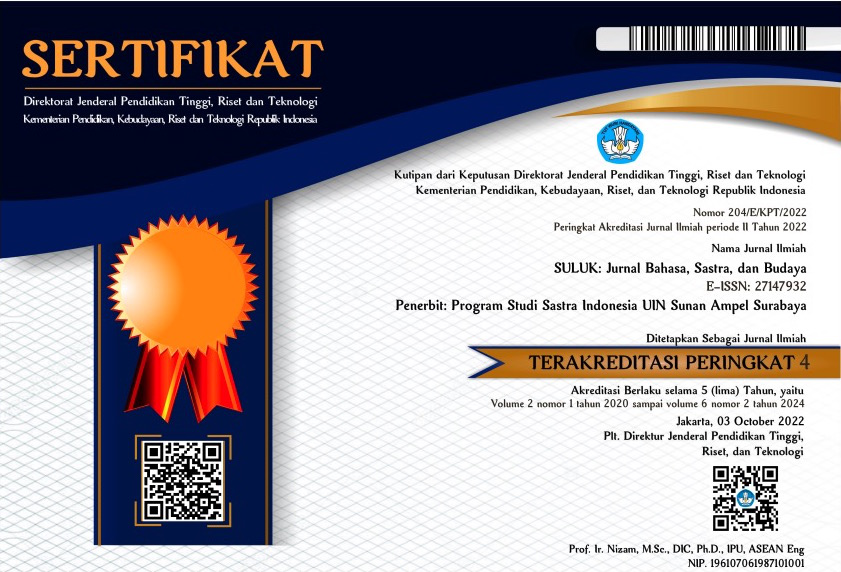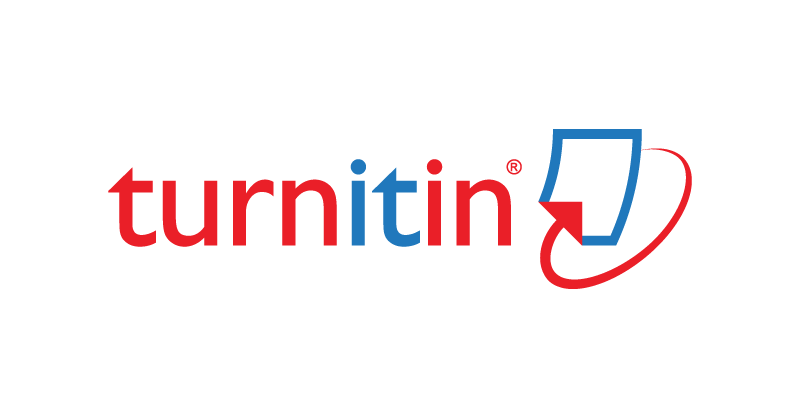Bundle-move analysis in research article of science and technology: connecting lexical bundles and rhetorical move
DOI:
https://doi.org/10.15642/suluk.2023.5.1.109-130Keywords:
lexical bundles, rhetorical move, corpus, research article, Indonesian writerAbstract
This research identifies lexical bundles which are connected to move analysis in research article of Science & Technology. The corpus-based analysis was used to acquire lexical bundles qualification of frequency and range. A number of bundles which were listed in the corpus were identified structurally and functionally using taxonomy approach by Biber et al., (2004). Further analysis was conducted to connect lexical bundles expression with rhetorical move. Connecting lexical bundles and move analysis in research articles aims to test whether lexical bundles can be used as move markers in academic discourse. The classification of move in a full-length research articles was adapted from Nwogu (1997). In the various structural and functional forms of bundles which are found in this study bring to the list of lexical bundles which indicate various move. The finding of this research is mainly supporting previous study where some bundles expressions have strong connection to rhetorical move in research article. Other finding shows that lexical bundles expressions could occur in more than one move. However, we found that not all of the bundles could express specific move (e.g. the value of the, the length of the, absorption process of the) and not all move is expressed by lexical bundles (move 8).
Downloads
References
Abdollahpour, Z., & Gholami, J. (2019). Embodiment of rhetorical moves in lexical bundles in abstracts of the medical sciences. Southern African Linguistics and Applied Language Studies, 37(4), 339–360. https://doi.org/10.2989/16073614.2019.1692681
Alamri, B. (2020). A Comparative Study of Saudi and International Journals of Applied Linguistics: The Move–Bundle Connection Approach. Journal of Language & Education, 6(2), 9–30. https://doi.org/10.17323/jle.2020.10531
Al-Shujairi, Y. B. J., Tan, H., Abdullah, A. N., Nimehchisalem, V., & Imm, L. G. (2020). Lexical Bundles in the Discussion Section Moves of High Impact Medical Research Articles. Social Sciences & Humanities, 28(3), 2043–2061.
Anthony, L. (2019). AntConc (3.5.8). Waseda University.
Anthony, L., & Lashkia, G. V. (2003). Mover: A machine learning tool to assist in the reading and writing of technical papers. IEEE Transactions on Professional Communication, 46, 185–193. https://doi.org/10.1109/TPC.2003.816789
Biber, D. (2009). A corpus-driven approach to formulaic language in English Multi-word patterns in speech and writing. International Journal of Corpus Linguistics, 14(3), 275–311. https://doi.org/10.1075/ijcl.14.3.08bib
Biber, D., Connor, U., & Upton, T. A. (2007). Discourse on the move: Using corpus analysis to describe discourse structure. John Benjamins Publishing Company.
Biber, D., Conrad, S., & Cortes, V. (2004). If you look at...: Lexical Bundles in University Teaching and Textbooks. Applied Linguistics, 25(3), 371–405.
Biber, D., Conrad, S., & Leech, G. (2002). Longman Student Grammar of Spoken and Written English. Pearson Education Limited.
Biber, D., Conrad, S., & Leech, G. (2003). Student Grammar of Spoken and Written English (2nd ed.). Pearson Education Limited.
Chen, Y.-H., & Baker, P. (2010). Lexical Bundles in L1 and L2 Academic Writing. Language, Learning & Teaching, 14(2), 30–49.
Cortes, V. (2004). Lexical bundles in published and student disciplinary writing: Examples from history and biology. English Fron Specific Purposes, 23(4), 397–423. https://doi.org/doi:10.1016/j.esp.2003.12.001
Cortes, V. (2013). The purpose of this study is to: Connecting lexical bundles and moves in research article introductions. Journal of English for Academic Purposes, 12, 33–43.
Cotos, E., Huffman, S., & Link, S. (2017). A move/step model for methods sections: Demonstrating Rigour and Credibility. English for Specific Purposes, 46, 90–106. http://dx.doi.org/10.1016/j.esp.2017.01.001
Deng, L., & Liu, J. (2022). Move–Bundle Connection in Conclusion Sections of Research Articles Across Disciplines. Applied Linguistics, 20(20), 1–29. https://doi.org/10.1093/applin/amac040
Ebrahimi, S. F., & Chan, S. H. (2018). Grammatical subject in results and discussion section of research articles: Disciplinary variations. Teaching English as a Second Language (Formerly Journal of Teaching Language Skills), 37(1), 97–125.
Hardjanto, T. D. (1997). Struktur wacana intisari artikel penelitian dalam jurnal ilmiah berbahasa Inggris. Humaniora, 5, 114–124.
Hong, J. (2019). Structural Use of Lexical Bundles in the Rhetorical Moves of L1 and L2 Academic Writing. English Teaching, 74(3), 29–54. https://doi.org/10.15858/engtea.74.3.201909.29
Hu, G., & Liu, Y. (2018). Three minute thesis presentations as an academic genre: A cross-disciplinary study of genre moves. Journal of English for Academic Purposes, 35, 16–30. https://doi.org/10.1016/j.jeap.2018.06.004
Hyland, K. (2002). Genre: Language, context, and literacy. In Annual Review of Applied Linguistics (Vol. 22, pp. 113–135). Cambridge University Press.
Hyland, K. (2015). Academic publishing: Issues and challenges in the construction of knowledge. Oxford University Press.
Hyland, K. (2008a). Academic clusters: Text patterning in published and postgraduate writing. Indonesian Journal of Applied Linguistics, 18(1), 41–62. https://doi.org/10.1111/j.1473-4192.2008.00178.x
Hyland, K. (2008b). As Can Be Seen: Lexical Bundles and Disciplinary Variation. English Fron Specific Purposes, 27(1), 4–21. https://doi.org/10.1016/j.esp.2007.06.001
Jiang, F. (Kevin), & Hyland, K. (2017). Metadiscursive nouns: Interaction and cohesion in abstract moves. English for Specific Purposes, 46, 1–14. http://dx.doi.org/10.1016/j.esp.2016.11.001
Kanoksilapatham, B. (2005). Rhetorical structure of biochemistry research articles. English for Specific Purposes, 24, 269–292. https://doi.org/10.1016/j.esp.2004.08.003
Kashiha, H. (2015). Recurrent Formulas and Moves in Writing Research Article Conclusions among Native and Nonnative Writers. 3L: The Southeast Asian Journal of English Language Studies – Vol 21(1): 47 – 59, 21(1), 47–59. http://dx.doi.org/10.17576/3L-2015-2101-05
Kim, E.-S., & Lee, E.-J. (2020). A Corpus-Based Study of Lexical Bundles and Moves by English L1 and L2 Writers in Medical Journal Abstracts. Korean Journal of English Language and Linguistics, 20, 768–800. https://doi.org/10.15738/kjell.20..202012.768
Kwan, B. S. C. (2006). The schematic structure of literature reviews in doctoral theses of applied linguistics. English for Specific Purposes, 25, 30–55. https://doi.org/10.1016/j.esp.2005.06.001
Li, L., Franken, M., & Wu, S. (2020). Bundle-driven move analysis: Sentence initial lexical bundles in PhD abstracts. English for Specific Purposes, 60, 85–97. https://doi.org/10.1016/j.esp.2020.04.006
Maswana, S., Kanamaru, T., & Tajino, A. (2015). Move analysis of research articles across five engineering fields: What they share and what they do not. Ampersand, 2, 1–11. https://doi.org/10.1016/j.amper.2014.12.002
Mizumoto, A., Hamatani, S., & Imao, Y. (2017). Applying the Bundle–Move Connection Approach to the Development of an Online Writing Support Tool for Research Articles. Language Learning, 67(4), 885–921. https://doi.org/10.1111/lang.12250
Moreno, A. I., & Swales, J. M. (2018). Strengthening move analysis methodology towards bridging the function-form gap. English for Specific Purposes, 50, 40–63. https://doi.org/10.1016/j.esp.2017.11.006
Nwogu, K. N. (1997). The Medical Research Paper: Structure and Functions. English for Specific Purposes, 16(2), 119–138.
Omidian, T., Shahriari, H., & Siyanova-Chanturia, A. (2018). A cross-disciplinary investigation of multi-word expressions in the moves of research article abstracts. Journal of English for Academic Purposes, 36, 1–14. https://doi.org/10.1016/j.jeap.2018.08.002
Paltridge, B. (2004). Academic writing. Language Teaching, 37(2), 87–105. https://doi.org/10.1017/S0261444804002216
Pan, F., Rappen, R., & Biber, D. (2016). Comparing Patterns of L1 Verus L2 English Academic Profesionals: Lexical Bundles in Telecomunications Research Journals. Journal of English for Academic Purposes, 21, 60–71. http://dx.doi.org/10.1016/j.jeap.2015.11.003
Parkinson, J. (2017). The student laboratory report genre: A genre analysis. English for Specific Purposes, 45, 1–13. http://dx.doi.org/10.1016/j.esp.2016.08.001
Qi, H., & Pan, F. (2020). Lexical bundles variation across moves in abstracts of medical reserach articles. Southern African Linguistics and Applied Language Studies, 38(2), 109–128. https://doi.org/10.2989/16073614.2020.1763814
Ren, J. (2021). Variability and functions of lexical bundles in research articles of applied linguistics and pharmaceutical sciences. Journal of English for Academic Purposes, 50(7), 1–16. https://doi.org/10.1016/j.jeap.2021.100968
Soler-Monreal, C., Carbonell-Olivares, M., & Gil-Salom, L. (2011). A contrastive study of the rhetorical organisation of English and Spanish PhD thesis introductions. English for Specific Purposes, 30, 4–17. https://doi.org/10.1016/j.esp.2010.04.005
Swales, J. M. (1981). Aspects of article introductions. The University of Aston, Language Studies Unit.
Swales, J. M. (1990). Genre analysis: English in academic and research settings. Cambridge University Press.
Yang, M. (2022). Connecting the Functions of Lexical Bundles and Moves in Published Research Articles: The Case of Developmental and Educational Psychology. Nordic Journal of English Studies, 21(1), 141–189.
Downloads
Additional Files
Published
How to Cite
Issue
Section
License
Copyright (c) 2023 Ina Insani, Ni Gusti Ayu Roselani

This work is licensed under a Creative Commons Attribution-ShareAlike 4.0 International License.
- Authors retain copyright and grant the journal right of first publication with the work simultaneously licensed under a Creative Commons Attribution ShareAlike License that allows others to share the work with an acknowledgment of the work's authorship and initial publication in this journal.
- Authors are able to enter into separate, additional contractual arrangements for the non-exclusive distribution of the journal's published version of the work (e.g., post it to an institutional repository or publish it in a book), with an acknowledgment of its initial publication in this journal.
- Authors are permitted and encouraged to post their work online (e.g., in institutional repositories, pre-print sites, or on their website) prior to and during the submission process, as it can lead to productive exchanges, as well as earlier and greater dissemination of published work.







